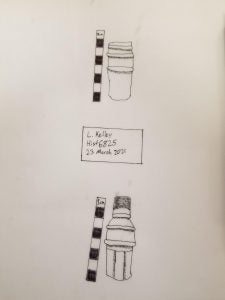These artifacts form a whole condiment set, with five individual pieces. There are four glass bottles and a metal holder. Three of the four glass bottles have a unique design, though all four were likely each intended for a different condiment. The first has a metal top, likely made of silver, is pierced with holes similar to saltshakers, which was likely its intended use; this artifact measures about 8cm tall, including its top. The second has a rounded removable glass top, as well as a shorter neck than the rest of the bottles, and is about 8.5cm tall including its top, which measures 2cm. Some concretion flakes were present inside the bottle but are likely unrelated to its intended contents. The two remaining bottles are almost identical, save for minor variations that occurred during their creation. They are approximately 9.5cm tall with their caps on, which measure 2.5cm tall. All four bottles were made by pressing glass and share a repeating pattern of a flower and a crest on their midsections.
The glass has become clouded on all four, with each sustaining different levels of corrosion; the bottle with the rounded top appears to be the least affected. The metal holder, or stand, appears to be made of the same metal as the cap, silver. It has a rounded upward sloping base that rises to meet a ring surrounding four circles, designed to perfectly fit the four glass condiment bottles. The shaft continues up to an ornate carrying handle. Its base has begun to corrode and sustained damage in the form of bending; the side of the ring where the bend is also is somewhat damaged as though it had been hit by something. The carrying handle is also beginning to corrode, with a fracture appearing near to where it connects with the shaft.

Since there was no archaeological documentation during the removal of artifacts, it can be difficult to know what may have been cargo bound for Texas and what belonged to passengers. This miniature condiment bottle set would have either belonged to a child passenger or have been intended as a Christmas gift for a child. If the child were on board the slowly sinking City of Houston, saving this set would have meant very little to them since it represented a more adult aspect of life. If it were to be a gift promised to a child, they may have been disappointed by its loss beneath the waves of the Atlantic only to be replaced with a different gift. Either way, it is difficult to know what the child who this may have belonged to may have felt, just as it is impossible to guess where in the vessel this may have come from, losing some understanding of the vessel and the people who relied on it and its goods.
